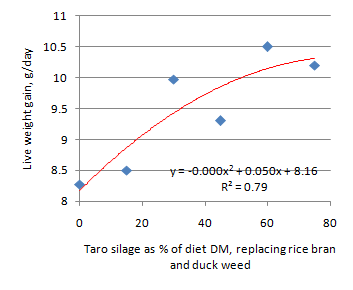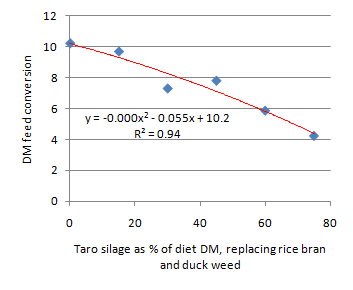 |
 |
Figure 1. Live weight gain increases as Taro silage as % of diet DM, replaces rice bran and duck weed |
Figure 2. Feed conversion improves as Taro silage as % of diet DM, replaces rice bran and duck weed |
|
MEKARN Conference 2010 |
Abstract
The experiment was carried out over 60 days which start from 6th July and finished at 3rd September 2010. A total of 162 local male ducks (9 heads per pen) were selected to study. The experimental design was completely randomized design (CRD) with six treatments and three replicate in each treatment. The levels of taro foliage silage (% in diet DM) were 0, 15, 30, 45, 60 and 75. Rice bran and duckweed were mixed together prior to feeding taro foliage silage. Taro foliage silage was fed close to appetite but with minimal feed refusals. Feed were given three times daily at 8:00, 12:00 and 16:00h. Water was offered ad libitum by putting into plastic bowl throughout the day.
The average daily intake was significant different (P<0.001) among 6 treatments which the value were 83.9, 80.9, 72.4, 72.0, 61.7 and 43.1g in DM and daily weight gain also significant different (P<0.05) which value was 8.27, 8.50, 9.97, 9.30, 10.5 and 10.2g and feed conversion ratio were also improved from10.2, 9.67, 7.29, 7.79, 5.86 and 4.23 for TF0, TF15, TF30, TF45, TF60 and TF75 respectively.
Key word: local, duck, taro foliage, silage, rice bran, duckweed, ad libitum
 |
 |
Figure 1. Live weight gain increases as Taro silage as % of diet DM, replaces rice bran and duck weed |
Figure 2. Feed conversion improves as Taro silage as % of diet DM, replaces rice bran and duck weed |